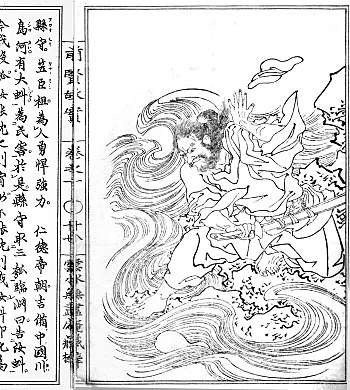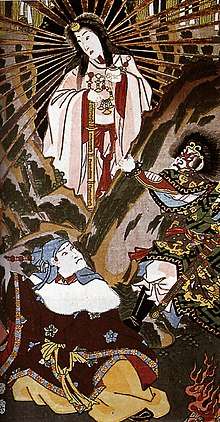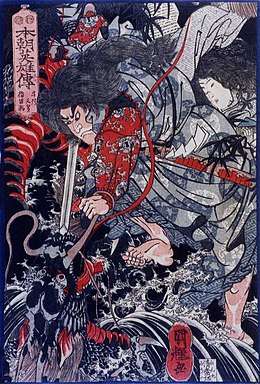Mizuchi
The Mizuchi (大虬, 蛟龍、蛟, 美都知) is a type of Japanese dragon or legendary serpent-like creature, either found in aquatic habitat or otherwise connected to water. Some commentators perceived it to have been a water deity. It is described in the ancient pseudo-chronicle Nihon Shoki and one Man'yōshū poem.

Etymology
In olden times pronounced mi-tsu-chi, the word can be broken down to mi "water" + tsu a particle meaning "of" + chi "spirit".[1] The -chi is glossed as a word root used only as a part of a compound word[2] (as a suffix, etc.)
Chinese character representation
Mizuchi is also the Japanese transliteration for several Chinese glyphs,[3] each glyph putatively representing a type of Chinese dragon: namely the jiāolóng (蛟竜; Japanese: kōryū) or "4-legged dragon", the qíulóng (虬竜 or 虯竜; Japanese: kyūryū) or "hornless dragon" and the chīlóng (螭竜; Japanese: chiryū) or "yellow dragon".
F. J. Daniels[lower-alpha 1] cautions that for okami (龗) and mizuchi, "it is unsafe to deduce their forms from the Chinese characters allotted to them".[5] Kunio Yanagita also emphasized that while the use of character like 虬 may suggest a snake-like being, it should be stressed that the mizuchi signifies a "water spirit".[6]
Early references
The ancient chronicle Nihongi contains references to mizuchi. Under the 67th year of the reign of Emperor Nintoku (conventionally dated 379 AD), it is mentioned that in central Kibi Province, at a fork on Kawashima River (川嶋河, old name of Takahashi River in Okayama Prefecture), a great water serpent or dragon (大虬) dwelt and would breathe or spew out its venom, poisoning and killing many passersby.[lower-alpha 2][8]
This mizuchi was exterminated by a man named Agatamori (県守), ancestor of the Kasa-no-omi (笠臣) clan. He approached the pool of the river, cast three calabashes which floated to the surface of the water and challenged the beast to make these gourds sink, threatening to slay it should it fail. The beast transformed into a deer and tried unsuccessfully to sink them, whereby the man slew the monster. The record goes on to say: "...He further sought out the water-dragon's fellows. Now the tribe of all the water-dragons filled a cave in the bottom of the pool. He slew them every one and the water of the river became changed to blood. Therefore that water was called the pool of Agatamori".[9][10]
A river-god reported seen in Nintoku 11 (putatively 323 AD) is also regarded by commentators to be a mizuchi, due to paralleling circumstances. On that year, the Mamuta dikes built along Yodo River kept getting breached and the Emperor guided by an oracular dream ordered two men, Kowa-kubi from Musashi Province and Koromo-no-ko from Kawachi Province be sought ought and sacrificed to the "River God" or Kawa-no-kami (河伯).[lower-alpha 3] One of the men, who resisted being sacrificed, employed the floating calabash and dared the River God to sink it as proof to show it was truly divine will that demanded him as sacrifice. A whirlwind came and tried, but the calabash just floated away, and thus he extricated himself from death using his wits. Although River God is not called mizuchi in the source, Aston has regarded the River God (Kawa-no-kami) and the mizuchi as equivalent.[11]
Visser concludes, "From this passage, we learn that in ancient times human sacrifices were made to the dragon-shaped river-gods".[12] Michael Dylan Foster suggests this is "perhaps the first documented appearance of the water spirit that would become known popularly in Japan as the kappa".[13][lower-alpha 4]
A mizuchi is also mentioned in the Man'yōshū, the ancient collection of Japanese poems. The tanka poem #3833 composed by Prince Sakaibe[16] can be loosely paraphrased to mean "I could ride a tiger to leap over the Old Shack, to the green pool, to take down the mizuchi dragon there, if only I had a sword capable of doing just that".[lower-alpha 5][18][19]
Folklorist studies
Polymath Minakata Kumagusu, in his essay Jūnishi kō: mi(hebi) (『十二支考』, "A Study of Twelve Animals of Chinese Zodiac") states "Even in our country (Japan), the various snakes that dwelled by water and were feared by people seemed to have been called mizuchi, or 'master of the water'".[20] Here Minakata draws on Edo Period scholar Motoori Norinaga' suggestion that the -chi signified an honorific.[21][lower-alpha 6] As stated above folklorist Yanagita emphasized the meaning of chi as "spirit".[6]
Corruption into kappa
Minakata also conjectured that in some parts of the country, mizuchi eventually came to be regarded as creatures of the kappa kind. This is because the kappa creatures are known locally by many names that sound much like mizuchi, such as mizushi (former Noto Province, Ishikawa Prefecture), medochi (Nanbu region, parts of Iwate, Aomori, Akita), mintsuchi (Ezo, now Hokkaido).[23][lower-alpha 7]
Furthermore, in the lore of Echigo Province (Niigata Prefecture), the kappa was said to abhor the calabash gourd,[25] which is reminiscent of the episodes in Nihon Shoki where the River God or mizuchi are challenged to submerge the calabashes.[26] Similar observations are made by folklorists Yanagita[27] and Jun'ichirō Ishikawa.[28]
Minakata was also encouraged by the fact that the snake and the kappa (alongside the suppon soft-shelled turtle) were grouped as three creatures known to kill humans in water by Asakawa Zen'an's essay Zen'an zuihitsu and conjectured that there used to be lore where sacred snakes which were "masters of the body of water" would transform into human form and wreak havoc, but terms such as mizushi became reserved for the kappa-kind, whereas the terms to refer to the "masters of the body of water" as mizuchi became forgotten.[29]
In popular culture
- (vehicles, vessels)
- Kōryū (submarine) (Japanese: 蛟竜), (synonymous with mizuchi), an ex-Japanese Navy submarine.
- Jiaolong (Chinese: 蛟龙号), a Chinese deep-ocean submersible.
- (novels)
- "Mizuchi" (『水霊 ミズチ』), a 1998 horror novel by Hirohumi Tanaka and its 2006 horror movie adaptation directed by Kiyoshi Yamamoto, entitled "Death Water" in English, though theme is "water spirit" and not dragon.
- Sohryuden: Legend of the Dragon Kings (novel) – A man named Mizuchi (水池) is an allusion.
- (manga, anime)
- Eight Clouds Rising – Mizuchi (水蛇, "Watersnake") is one of seven divine swords.
- GeGeGe no Kitaro (manga, anime) – a kōryū (syn. mizuchi) appears as adversary.
- Omamori Himari (manga, novella, anime) – the character Shizuku is a mizuchi.
- Our Home's Fox Deity. – A miko priestess is possessed by a mizuchi.
- Samurai Deeper Kyo (manga) – Demon Eyes Kyo uses an attack called "mizuchi" in his sword fighting style. Compare Japanese kōryū or kōryō 蛟竜 "rain dragon; hidden genius; Kaiten torpedo".
- Noragami (manga, anime) – the character Nora is called Mizuchi by Father and is frequently shown walking over water.
- Spirited Away (anime, movie) – the character Haku looks like a Mizuchi, and he is a river spirit.
- (games)
- Mah-jong Fight Club (game) – player character becomes kōryū (one of the true dragons) when certain conditions are met.
- Monster Hunter 2 (PS 2) – an elder dragon type named Ōnazuchi is a take on mizuchi; named Chameleos in English-language platforms.
- Neo Geo Battle Coliseum (game) – a boss character named Mizuchi, a clone of Orochi from The King of Fighters '97
- Ōkamiden (game) – a water dragon boss that used to be the guardian of a seaside village.
- Nioh 2 (game) – there is a water dragon guardian spirit called Mizuchi that the player can be imbued to characters to gain protection and special effects.[30]
Explanatory notes
- Emeritus Professor of Japanese at University of London, died August 1983.[4]
- The text designates the creature as a qiulong (虬/虯) in Chinese prose (kanbun), but the annotation gives its Japanese reading as mitsuchi.[7]
- Note that 河伯 in China designates the Hebo deity.
- In Japanese folklore the kappa is a water sprite often considered benignly mischievous,[14] (and thus may appear unlike a sacrifice-demanding serpent). But the kappa can also be seen as sinister, reaching in and extracting the liver or the shirikodama from humans.[15]
- The shark (鮫) character in the poem's original text is emended to the mizuchi (蛟) character. Kariya Ekisai in his annotation to the Wamyō Ruijushō remarks: "Considering the Manyōshū (quote follows).. the kōryō/jiaolong ` shark-dragon´ is actually kōryō/jiaolong ` flood dragon´, and correctly read as ` midzuchi´ 万葉集を按ずに.. 鮫龍即蛟龍也、宜しく美都知と訓ず".[17]
- Minakata misquoted Norinaga, but Norinaga said chi was the honorific. Minakata wrote: "When Motoori Norinaga said tsuchi was an honorific, he must have interpreted it as a master of water or somesuch 本居宣長はツチは尊称だと言ったは、水の主ぬしくらいに解いたのだろ".[21]) What Norinaga actually stated was "there are many examples of [deities' names that are called] so-and-so -zuchi, where zu is a word akin to "of" while chi is an honorific 某豆知(なにづち)と云例あまたありて..豆(づ)は之(の)に通ふ辞、知(ち)は称名(たたへな)なり".[22]
- Cf. other local synonyms of kappa such as medochi (Ehime prefecture) and mizushi (Fukui prefecture) mentioned by Asakawa Zen'an's Zen'an zuihitsu.[24]
References
- Citations
- Shinmura, Izuru 新村出 (1991). "mizuchi みずち【蛟】". Kōjien 広辞苑 (4 ed.). Iwanami. (electronic edition). Cf. also entry for "chi" ち【霊】
- Shinmura, Izuru 新村出, ed. (1991). "chi" ち【霊】. Kōjien 広辞苑 (4 ed.). Iwanami. (electronic edition).
- Shinmura, Izuru 新村出, ed. (1976). "mizuchi" みずち【蛟・虬・虯・螭】. Kōjien 広辞苑 (2nd expanded ed.). Iwanami.
- Blacker, Carmen (1983), "Obituary: Professor F. J. Daniels", Folklore, 94 (2): 251, doi:10.1080/0015587X.1983.9716286
- Daniels (1960), p. 157.
- Yanagita 2004, 32;573; "Since we now write the word as 虬, it would strike people with Chinese knowledge that this might be a type of snake, but the meaning of the word merely consists of the word for‘water’attached with the character chi which means something like ‘spiritual being’, so it signifies none other than a water spirit. 今では虬と書くので、支那の知識を持っている人たちは蛇の類だろうと思っているが、字義からいっても水という言葉に、霊物とか何とかいう意味のチという字がついているだけなのだから、水の霊ということに外ならない".
- Ishizuka, Harumichi 石塚晴通 (2007). Sonkeikaku Bunko-bon Nihonshoki honbun kunten sōsakuin 尊経閣文庫本日本書紀本文・訓点総索引. Yagi shoten. p. 38. ISBN 4840694117.
- "巻十一〈仁徳天皇紀〉の67年". Nihon shoki 日本書紀. J-texts. Retrieved 2019-07-24.
是歳於吉備中国川嶋河派有大虬令苦人時路人触其処而行必被其毒以多死亡...
- Nihon shoki, Book 11., Nintoku Tenno, year 67. Original text: "是歳於吉備中国川嶋河派有大虬令苦人時路人触其処而行必被其毒以多死亡"
- tr. Aston (1896), 1, p. 299.
- Aston (1905), 1: 150–151
- Visser (1913), p. 139.
- Foster (1998), p. 2.
- Foster (1998), pp. 1, 4
- Foster (1998), p. 6.
- Man'yōshū #3833 by Prince Saikabe, original text:"虎尓乗 古屋乎越而 青淵尓 鮫龍取将来 劒刀毛我"
- Kariya, Ekisai 狩谷棭斎 (1883). "Dragon and fish division no. 18 竜魚部第十八". Senchū wamyō ruijushō 箋注倭名類聚抄 巻第8. Government printing office., fol. 2r–2v
- Takeda (1972), 3: 1: "[I would] ride a tiger and leap over Furuya (Old Shack), and I want a sword enough to destroy the dragon in the green pool. Furuya (Old Shack) may be a place name but location is unknown. 虎に乗って古屋を越えて、青渕で竜を退治してくるような刀剣がほしいなあ; .. 古屋、地名だろうが、所在不明".
- Ito (2005), 8: 475: "Astride a tiger, leaping over an old shack's rooftop, then at the creepy green pool, its lord.. the mizuchi dragon to capture, if I only had such a two-handed or great-sword capable of that. 虎にまたがり、古屋の屋根を飛び越えて行って、薄気味悪い青淵で、その主..蛟龍を捕らえて来られるような、そんな剣大刀があればよいのに".
- Minakata (1917); Minakata (1984), "Year of the Snake", p. 159
- Minakata 1916; Minakata 1984, "Year of the Dragon", p. 116
- Motoori, Norinaga 本居宣長 (1822), "Yamata no orochi section 【八俣遠呂智の段】", Kojikiden , 9-2 (commentary on Kamiyo volume 7) 『古事記傳』9-2(神代七之巻)CS1 maint: ref=harv (link) in: Motori 1968 Motoori Norinaga Zenshū 9, Tsukuma Shobo, pp. ; also: Kumo no ikada 雲の筏. "Kojikiden (in modern Japanese translation)". Retrieved July 23, 2019.CS1 maint: ref=harv (link)
- Minakata (1984), "Year of the Dragon", p. 117; "Year of the Serpent", p. 159
- Asakawa, Zen'an 朝川善庵 (1927). "Zen'an zuihitsu 善庵随筆". In Kusunose, Jun 楠瀬恂 (ed.). Zuihitsu bungaku senshū 随筆文学選集. 7. Shosaisha. pp. 339–340.CS1 maint: ref=harv (link); Selection in html markup at Tsubota, Atsuo 坪田敦緒 (ed.). "Zen'an zuihitsu kan 1 善庵随筆 巻一". Sumōhyōronkanopēji 相撲評論家之頁. Archived from the original on 2008-03-18. Retrieved 2019-07-19.
- Yanagita, Kunio (1914), Santō mintan shū, p. 84, cited by Minakata
- Minakata (1984), "Year of the Dragon", p. 117
- Yanagita, Kunio 柳田國男 (2014) [1959]. Ishii, Masami 石井正己 (ed.). Yanagita Kunio no kokyo nanajūnen 柳田国男の故郷七十年. PHP Kenkyusho. p. 133. ISBN 4-569-82106-5.CS1 maint: ref=harv (link)
- Ishikawa, Jun'ichiro 石川純一郎 (1985) [1974]. Shinban kappa no sekai 新版河童の世界 [New edition world of kappa]. Jiji Tsushin Shuppankyoku. pp. 45–50, 64–65 248. ISBN 4-788-78515-3.CS1 maint: ref=harv (link)
- Minakata (1984), "Year of the Serpent", p. 159
- "Mizuchi - Nioh 2". Nioh 2 Wiki. Retrieved 2020-07-20.
- Bibliography
- (primary sources)
- Nihongi: Chronicles of Japan from the Earliest Times to A.D. 697. 1. Translated by Aston, William George. London: Japan Society of London. 1896.
- Yoshimoto, Makoto; Okajima, Akihiro, eds. (1998). "Manyōshū: volume 16, poem by Prince Sakaibe, number 3833" [題詞]境部王詠數種物歌一首. Japanese Text Initiative. University of Virginia Library. Archived from the original on 2012-04-26. Retrieved 2012-07-23.: submit "3833" in box to load Poem 3833.
- (Secondary sources)
- Aston, William George (1905). Shinto: (the Way of the Gods). Longmans, Green, and Co.CS1 maint: ref=harv (link)
- Daniels, F. J. (1960). "Snake and Dragon Lore of Japan". Folklore. 71 (3): 145–164. doi:10.1080/0015587x.1960.9717234.CS1 maint: ref=harv (link)
- Foster, Michael Dylan (1998). "The Metamorphosis of the Kappa: Transformation of Folklore to Folklorism in Japan". Asian Folklore Studies. 56 (1): 1–24. doi:10.2307/1178994. JSTOR 1178994.CS1 maint: ref=harv (link)
- Ito, Hiroshi 伊藤博 (2005). Man'yōshū chūshaku 萬葉集釋注. 8. Shueisha. p. 475.CS1 maint: ref=harv (link)
- Minakata, Kumagusu 南方熊楠 (1916), "Jūnishikō (3): Tawara Tōda Ryūgu iri no hanashi" 十二支考(3):田原藤太竜宮入りの話 [On the Zodiac (3): Story of Tawara Tōta's entry into Ryūgū Dragon Palace], Taiyō. Aozora Bunko No.1916
- Minakata, Kumagusu 南方熊楠 (1984), "Tawara Tōda Ryūgu iri no hanashi" [Year of the Dragon], Minakata Kumagusu senshū 1: Jūnishi kō 1, Heibonsha, pp. 83–158
- Minakata, Kumagusu 南方熊楠 (1917), "Jūnishikō (4): hebi ni kansuru minzoku to densetsu" 十二支考(4):蛇に関する民俗と伝説 [On the Zodiac (4): folklore and legends of the serpent], Taiyō. Aozora Bunko No.2536
- Minakata, Kumagusu 南方熊楠 (1984), "Hebi ni kansuru minzoku to densetsu" [Year of the Serpent], Minakata Kumagusu senshū 1: Jūnishi kō 1, Heibonsha, pp. 159–222
- Takeda, Yūkichi 武田祐吉 (1972). Manyōshū zenkō 萬葉集全講. 3. Meiji shoin. p. 1.CS1 maint: ref=harv (link)
- Yanagita, Kunio 柳田國男 (2004), Kappa no hanashi 河童の話, Yanagita Kunio Zenshū, 32, p. 573
- Visser, Marinus Willem de (1913), "§4 Mizuchi, the river-gods", The Dragon in China and Japan, Amsterdam: J. Müller, pp. 137–139

